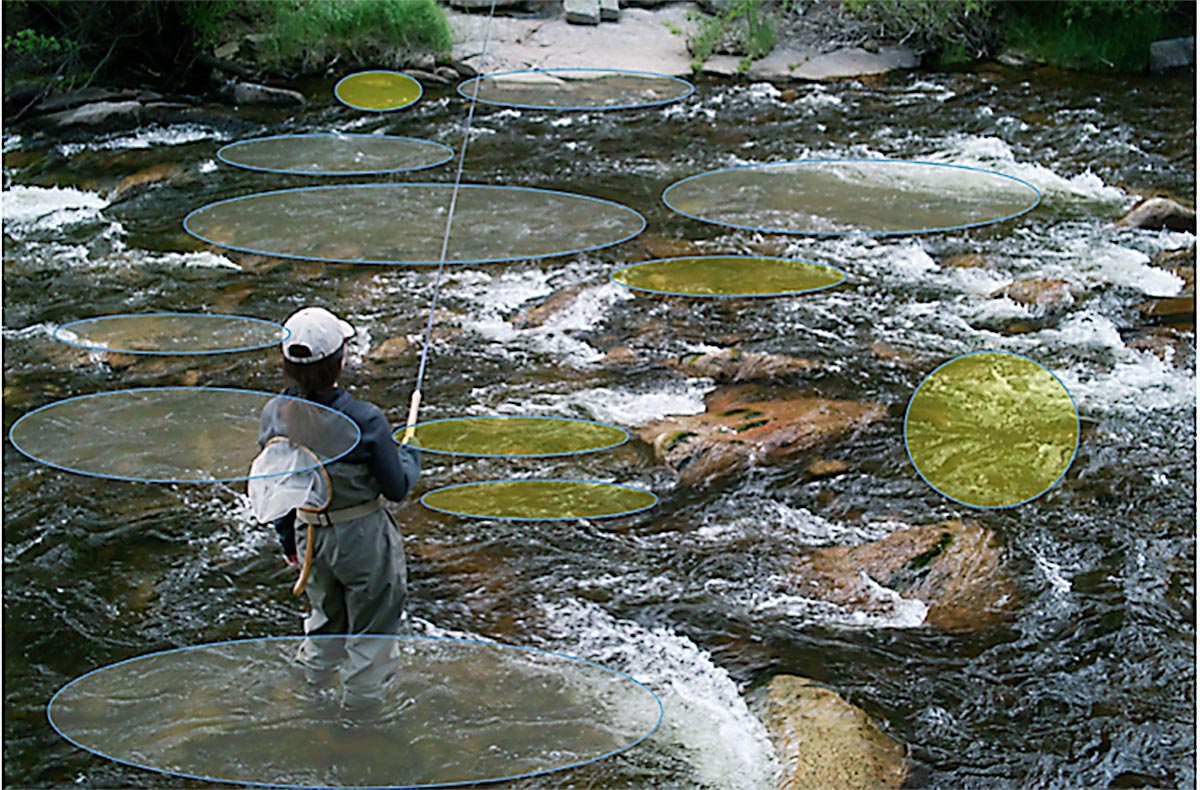By Daniel Galhardo
I got inspired to write this post after reading Kent Klewein’s post about how about all seams hold fish,
And after taking a couple of people tenkara fishing in a mountain stream yesterday. In line with Kent’s post, I can tell you that most pockets, even the ones you don’t see, hold fish.
Fly anglers quickly learn where to find trout in mountain streams. I always talk about the two main things trout are looking for: currents to bring them food, and calm water to allow them to stay put without spending a lot of energy. I suggest the seams where calm and fast water meet and other calm pockets of water as great places to target.
Mountain streams have a lot of visible and obvious places where fish are likely to hold. Boulders and logs form these pools that just look “fishy”, and like good homes. With a quick one minute lesson on reading water, most novice anglers will immediately see where to go cast their fly: “upstream to that big calm pocket over there.”
While it is easy to see and then go fish the most obvious spots, mountain streams also have a lot of what I call invisible waters.
Invisible waters are those very small pockets of calm water that nobody targets. Most likely because most people don’t notice them, but also because anglers may not think they have fish in them. The turbulence around these waters betrays their depth and fish-holding ability. Their proximity to the banks or their small size eludes our tunnel vision, which concentrates on the most likely places to hold fish.
Invisible waters are my favorite waters to fish. While the majority of anglers readily ignore these pockets, I have caught plenty of fish out of them. When I know I am trailing someone on a stream, these invisible waters give me a place to cast my fly to fish I know have not seen a fly that day, or perhaps that whole week or even longer.
The two people I took fishing yesterday were good at reading water. They readily identified some of the seams; they picked foam lines; they worked from the tail-end of the pool on upstream to the head of the pool, which in a mountain stream forms a great “food delivery system” with the currents dropping food in.
But, as we walked, I noticed they were so focused on the obvious waters that sometimes they would go and stand in waters I would have definitely cast.
I decided to intervene and talk a bit about one of my great loves, the waters everyone has ignored for quite a while. On my first cast I showed them a pocket that was not particularly small, in fact it may have been about 4 feet long, but there was a lot of turbulence on two sides of it, and there was a barely visible slick of calmer water, about 1ft in width, formed between these two currents. On my first cast I had as strike. I missed the fish, but proved my point. On my next cast, I showed them a pocket that couldn’t have been bigger than 1ft in diameter. But, it was relatively deep, and very calm. I knew I could place my fly there and hold it there for a couple of seconds. I cast, the fly stayed there without effort, and a nice 9” brown trout came up. The water was invisible to them until the moment a fish showed itself.
Daniel Galhardo Gink & Gasoline www.ginkandgasoline.com hookups@ginkandgasoline.com Sign Up For Our Weekly Newsletter!



Great post, really helpful!
This is why any angler should hire a good Guide, he knows where to look to find the fish that are neglected, it is why he is worth every dime he earns!
Unless you have no clue, I’d say learn to read the water and save the money for a guide.
I agree you should use the experience of a guide when available. You are giving away all of the secrets. 🙂
Guides are a wonderful think ! Everyone should use one, especially when your fishing new waters. I don’t get all the time I want to fish, but if I’m going somewhere new for a few days, a Guide is your best investment.
Just the experience of learning a new or better technic is invaluable.
I would fish with this author if I had the chance.just to have someone who is this good standing beside me for a day and teaching me …….
Sign me up
There is a website I check on periodically that some very accomplished members often post pics of a river section that they fished, and ask where the fish were and what would be the best technique to catch them.
Other members take the photo and mark them up with the areas they believe the fish would reside, and post up the marked photos in response.
And then the original poster will do the same, showing where he caught all his fish.
Very similar to the photo accompanying this topic, and very, very educational!
Great job Daniel!
Best,
Andy
Pingback: Tipppets: Tying Bonefish Leaders, Invisible Waters | MidCurrent
Pingback: Tips for fishing invisible waters | Lackawanna Valley TU Blog